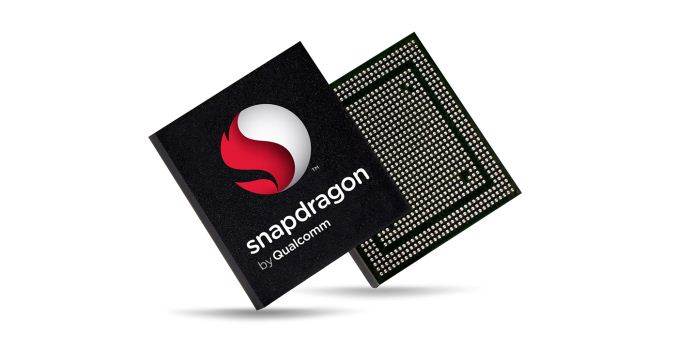Today at Qualcomm’s 2016 4G/5G Summit in Hong Kong, the company announced several new additions to its low- and mid-tier Snapdragon SoC lineup, including the Snapdragon 427, 626, and 653. Each new Snapdragon SoC builds on its predecessor, adding a few key features.
The new Snapdragon 653 is the “Pro” version of the existing 652 similar to how the Snapdragon 821 is a “Pro” version of the 820. Qualcomm raised the max frequency of the Snapdragon 653’s four ARM Cortex-A72 CPUs to 1.95GHz, up from 1.80GHz in the 652, but kept the max frequency of the four ARM Cortex-A53 CPUs the same. There’s still an Adreno 510 GPU in the new SoC, but its peak frequency has also been increased.
The Snapdragon 653 still uses LPDDR3-1866 memory with 14.9GB/s of bandwidth like the 652, but doubles the amount of addressable RAM from 4GB to 8GB. This is a prudent extension given the current trend towards 4GB and 6GB configurations for Android phones in the mid-range segment and flagship phones pushing towards 8GB.
The Snapdragon 653 also received a modem upgrade: The Snapdragon X9 LTE modem replaces the Snapdragon X8 LTE modem in the 652. The X9 still supports up to 300Mbps on the downlink using 2x20MHz carrier aggregation and 64-QAM (Category 7), but boosts the uplink to 150Mbps by adopting 64-QAM (Category 13). The X9 can also improve call clarity when using the Enhanced Voice Services (EVS) codec for VoLTE calls.
| Qualcomm Snapdragon Mid-Range to High-End SoCs | ||||
| SoC | Snapdragon 650 (MSM8956) |
Snapdragon 652 (MSM8976) |
Snapdragon 653 (MSM8976 Pro) |
Snapdragon 820 / 821 (MSM8996 / MSM8996 Pro) |
| CPU | 2x Cortex-A72 @ 1.80GHz 4x Cortex-A53 @ 1.44GHz |
4x Cortex-A72 @ 1.80GHz 4x Cortex-A53 @ 1.44GHz |
4x Cortex-A72 @ 1.95GHz 4x Cortex-A53 @ 1.44GHz |
2x Kryo @ 2.15GHz / 2.34GHz 2x Kryo @ 1.59GHz / 2.19GHz |
| GPU | Adreno 510 | Adreno 530 @ 624MHz / 653MHz | ||
| Memory | 2x 32-bit @ 933MHz LPDDR3 14.9GB/s |
2x 32-bit @ 1866MHz LPDDR4 29.9GB/s |
||
| ISP/Camera | Dual ISP 21MP |
Dual 14-bit Spectra ISP 25MP / 28MP |
||
| Encode/Decode | 2160p30, 1080p120 H.264 & H.265 |
2160p30 (2160p60 decode), 1080p120 H.264 & H.265 |
||
| Integrated Modem | Snapdragon X8 LTE (Category 7) DL = 300Mbps 2x20MHz CA, 64-QAM UL = 100Mbps 2x20MHz CA, 16-QAM |
Snapdragon X9 LTE (Category 7/13) DL = 300Mbps 2x20MHz CA, 64-QAM UL = 150Mbps 2x20MHz CA, 64-QAM |
Snapdragon X12 LTE (Category 12/13) DL = 600Mbps 3x20MHz CA, 256-QAM UL = 150Mbps 2x20MHz CA, 64-QAM |
|
| Mfc. Process | 28nm HPm | 14nm LPP | ||
* Snapdragon SoCs still in production but not shown: 810, 808, 805, 801, 800
The Snapdragon 625 gets a new “Pro” version too in form of the Snapdragon 626. Both of the Cortex-A53 CPU clusters get a boost from 2.0GHz to 2.2GHz, but Qualcomm did not disclose the frequency of the Adreno 506 GPU.
The Snapdragon 625’s X9 LTE modem carries over to the 626, but the new SoC updates Bluetooth support from 4.1 to 4.2. The Snapdragon 626 also supports Qualcomm’s TruSignal antenna boost technology, which optimizes reception in weak signal strength conditions and from the attenuation that occurs when holding a phone. Working together with the antenna matching tuner (a separate IC that’s part of Qualcomm’s RF360 suite) and transceiver, the X9 LTE modem in the Snapdragon 626 performs the processing that enables the dynamic tuning.
| Qualcomm Snapdragon Mid-Range SoCs | ||||
| SoC | Snapdragon 615 / 616 (MSM8939) |
Snapdragon 617 (MSM8952) |
Snapdragon 625 / 626 (MSM8953 / MSM8953 Pro) |
|
| CPU | 4x Cortex-A53 @ 1.70GHz 4x Cortex-A53 @ ? |
4x Cortex-A53 @ 1.50GHz 4x Cortex-A53 @ ? |
4x Cortex-A53 @ 2.00GHz / 2.20GHz 4x Cortex-A53 @ 2.00GHz / 2.20GHz |
|
| GPU | Adreno 405 | Adreno 506 | ||
| Memory | 1x 32-bit @ 800MHz LPDDR3 6.4GB/s |
1x 32-bit @ 933MHz LPDDR3 7.46GB/s |
||
| ISP/Camera | 21MP | Dual ISP 24MP |
||
| Encode/Decode | 1080p30 H.264 / 1080p60 H.264 & H.265 |
2160p30 H.264 & H.265 |
||
| Integrated Modem | Gobi 4G LTE / Snapdragon X5 LTE (Category 4) DL = 150Mbps 1x20MHz CA, 64-QAM UL = 50Mbps 1x20MHz CA, 16-QAM |
Snapdragon X8 LTE (Category 7) DL = 300Mbps 2x20MHz CA, 64-QAM UL = 100Mbps 2x20MHz CA, 16-QAM |
Snapdragon X9 LTE (Category 7/13) DL = 300Mbps 2x20MHz CA, 64-QAM UL = 150Mbps 2x20MHz CA, 64-QAM |
|
| Mfc. Process | 28nm LP | 14nm LPP | ||
The Snapdragon 427 (MSM8920) is the newest member of the lower-tier 400 series, which now encompasses seven Snapdragon SoCs (400, 412, 415, 425, 427, 430, 435), ranging from the Snapdragon 400—containing either a dual-core Krait 300 or quad-core Cortex-A7 CPU and an Adreno 306 GPU—to the 435 and its octa-core Cortex-A53 CPU running at up to 1.4GHz with an Adreno 505 GPU and X8 LTE modem.
Like the other two new SoCs, the Snapdragon 427 is an update to an existing SoC. It has all the same features as the Snapdragon 425, including a quad-core A53 CPU running at up to 1.4GHz, an Adreno 308 GPU, a dual ISP supporting up to a 16MP camera, and single-channel LPDDR3-1334 memory all on a 28nm LP process. The sole change is an upgrade from the X6 LTE modem (Category 4) to the X9 LTE modem (Category 7/13), boosting peak downlink/uplink performance from 150Mbps/75Mbps to 300Mbps/150Mbps. This gives the new Snapdragon 427 the highest performing modem of the 400 series—and the only SoC in this tier to support Qualcomm’s TruSignal technology—but the 430 and 435 contain a faster GPU and ISP. Because the Snapdragon 427 maintains full pin and software compatibility with the 425, 430, and 435, it offers OEMs an easy path to adding the X9 LTE modem to their products.
Both the Snapdragon 653 and 626 SoCs should be commercially available by the end of 2016, while the Snapdragon 427 should appear in commercial devices in early 2017.







